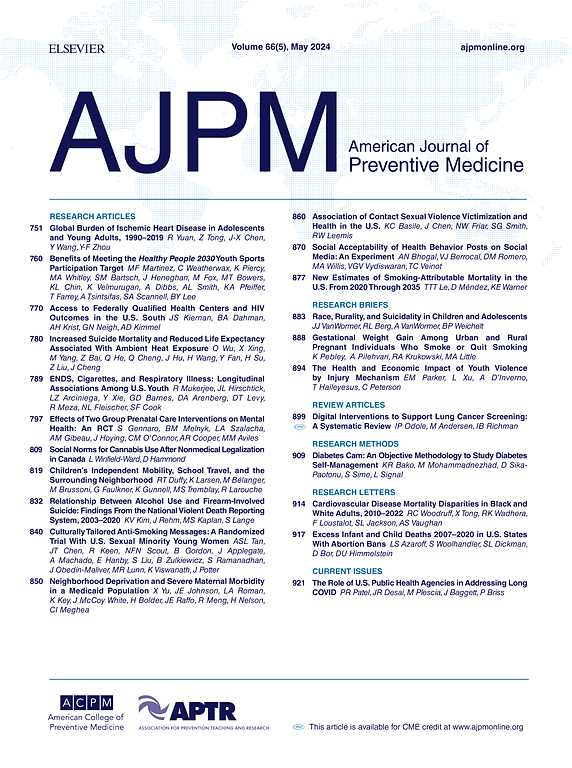Greater Appeal and Greater Harm? Young Adults’ Preference for Menthol Versus Nonmenthol Very-Low-Nicotine Cigarettes in a Cross-Over Trial
IF 4.5
2区 医学
Q1 MEDICINE, GENERAL & INTERNAL
引用次数: 0
Abstract
Introduction
The U.S. Food and Drug Administration proposed rulemaking to reduce cigarette nicotine content and ban menthol in cigarettes. Menthol is popular among young adults who smoke, although it is unclear how this group would respond if both policies were implemented.
Methods
A total of 112 young adults who smoke menthol cigarettes completed 3 visits that varied by cigarette smoked (2021–2024): usual brand menthol, menthol very-low-nicotine cigarette (0.3 mg nicotine/g tobacco), and nonmenthol very-low-nicotine cigarette. Very-low-nicotine cigarette flavor order was counterbalanced. Subjective response and smoking topography were assessed at each session as well as pre–post smoking measurements of expired carbon monoxide, cigarette weight, cardiovascular effects, nicotine withdrawal, and craving. Repeated-measures ANOVAs were used to examine differences in the outcomes across cigarette type.
Results
Total smoking duration, interpuff interval, and puff count were higher for usual brand than for both very-low-nicotine cigarette smoking. Interpuff interval was higher in menthol very-low-nicotine cigarette smoking than nonmenthol. Usual brand was more appealing than both very-low-nicotine cigarettes and led to greater increases in carbon monoxide and cardiovascular effects and decreased postsmoking cigarette weight and craving compared with both very-low-nicotine cigarettes. Menthol very-low-nicotine cigarettes produced more positive subjective responses, higher carbon monoxide, and lower postsmoking cigarette weight and craving than nonmenthol.
Conclusions
Participants preferred menthol over nonmenthol very-low-nicotine cigarettes, although very-low-nicotine cigarettes were less appealing than usual brand, overall. Despite similar topography across very-low-nicotine cigarette flavors, toxicant exposure and craving were greater and lower, respectively, after menthol than after nonmenthol very-low-nicotine cigarette smoking. Findings support the U.S. Food and Drug Administration’s proposals to ban menthol cigarettes and institute market-wide reductions in cigarette nicotine content.
更大的吸引力和更大的危害?在一项交叉试验中,年轻人对薄荷醇和非薄荷醇低尼古丁香烟的偏好。
导言:美国食品和药物管理局(FDA)提议制定法规,以减少香烟中的尼古丁含量并禁止香烟中的薄荷醇。薄荷醇在吸烟的年轻人中很受欢迎,尽管目前还不清楚如果这两项政策都得到实施,这个群体会有什么反应。方法:112名吸烟薄荷卷烟的年轻人完成了三次不同香烟吸烟的访问(2021-2024):常规品牌(UB)薄荷卷烟,薄荷极低尼古丁卷烟(VLNC);0.3mg尼古丁/g烟草)和非薄荷醇VLNC。VLNC风味顺序平衡。在每个阶段评估主观反应和吸烟地形,以及吸烟前后测量过期CO,香烟重量,心血管影响,尼古丁戒断和渴望。使用重复测量方差分析来检查不同香烟类型的结果差异。结果:UB吸烟的总吸烟时间、间隔期(IPI)和吸烟次数高于VLNC吸烟。薄荷醇VLNC吸烟者的IPI高于非薄荷醇VLNC吸烟者。与两种VLNCs相比,UB比两种VLNCs更有吸引力,并且导致CO和心血管效应的更大增加,并且减少了吸烟后的体重和渴望。薄荷醇(与非薄荷醇相比)vncs产生了更积极的主观反应,更高的CO,更低的吸烟后体重和渴望。结论:参与者更喜欢薄荷醇而不是非薄荷醇的VLNCs,尽管VLNCs总体上不如UB有吸引力。尽管不同VLNC口味的地形相似,但薄荷醇(与非薄荷醇)VLNC吸烟后,有毒物质暴露更大,渴望更低。调查结果支持FDA禁止薄荷香烟和在市场范围内减少香烟尼古丁含量的建议。
本文章由计算机程序翻译,如有差异,请以英文原文为准。
求助全文
约1分钟内获得全文
求助全文
来源期刊

American Journal of Preventive Medicine
医学-公共卫生、环境卫生与职业卫生
CiteScore
8.60
自引率
1.80%
发文量
395
审稿时长
32 days
期刊介绍:
The American Journal of Preventive Medicine is the official journal of the American College of Preventive Medicine and the Association for Prevention Teaching and Research. It publishes articles in the areas of prevention research, teaching, practice and policy. Original research is published on interventions aimed at the prevention of chronic and acute disease and the promotion of individual and community health.
Of particular emphasis are papers that address the primary and secondary prevention of important clinical, behavioral and public health issues such as injury and violence, infectious disease, women''s health, smoking, sedentary behaviors and physical activity, nutrition, diabetes, obesity, and substance use disorders. Papers also address educational initiatives aimed at improving the ability of health professionals to provide effective clinical prevention and public health services. Papers on health services research pertinent to prevention and public health are also published. The journal also publishes official policy statements from the two co-sponsoring organizations, review articles, media reviews, and editorials. Finally, the journal periodically publishes supplements and special theme issues devoted to areas of current interest to the prevention community.
 求助内容:
求助内容: 应助结果提醒方式:
应助结果提醒方式:


